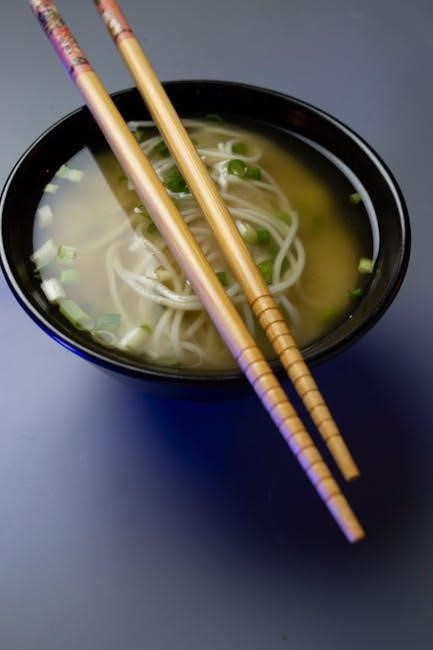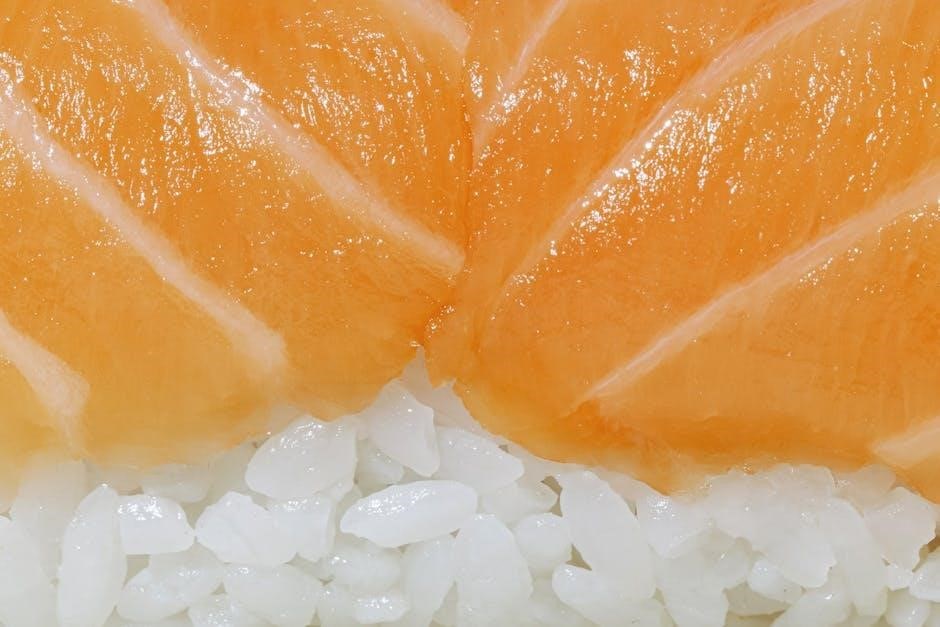
sashimi nutrition guide
Sashimi is a traditional Japanese dish of thinly sliced raw fish, celebrated for its fresh flavor and high nutritional value. It’s low in calories, high in protein, and rich in omega-3s, making it a popular choice for health-conscious individuals and culinary enthusiasts alike.
1.1 What is Sashimi?
Sashimi is a traditional Japanese dish consisting of thinly sliced raw fish or seafood, served without rice or other ingredients. It emphasizes the natural flavor and texture of the fish, often accompanied by soy sauce, wasabi, and garnishes like shiso or daikon. Unlike sushi, which includes vinegared rice, sashimi focuses solely on the freshness and quality of the raw ingredients. Popular types include salmon, tuna, mackerel, and octopus, each offering unique flavors and textures. Sashimi is celebrated for its simplicity, culinary artistry, and nutritional benefits, making it a beloved dish worldwide for both its taste and health advantages.

1.2 Cultural Significance of Sashimi
Sashimi holds deep cultural significance in Japan, representing a centuries-old culinary tradition that emphasizes freshness, simplicity, and artistry. It is often served at special occasions and celebrations, symbolizing purity and elegance. The dish reflects Japan’s reverence for nature, as it highlights the natural flavors and textures of raw ingredients. Sashimi also embodies the concept of “shun,” or seasonality, with ingredients often sourced locally and served at their peak freshness. The preparation of sashimi is considered an art form, requiring skill and precision, and it is often seen as a reflection of the chef’s dedication and craftsmanship. This dish is a cornerstone of Japanese cuisine, cherished for its cultural and culinary value.

1.3 Popularity of Sashimi as a Healthy Dish
Sashimi has gained global popularity as a healthy dish due to its low-calorie, high-protein, and nutrient-rich profile. It is particularly favored by health-conscious individuals for its ability to provide essential nutrients without excess fat or carbohydrates. The dish is also rich in omega-3 fatty acids, which support heart health and reduce inflammation. Sashimi’s fresh, clean flavors and delicate textures make it a satisfying option for those seeking a light yet nourishing meal. Its association with Japanese cuisine, known for emphasizing natural ingredients and minimal processing, further enhances its reputation as a wholesome choice. This makes sashimi a standout option in modern diets focused on wellness and sustainability.
Nutritional Profile of Sashimi
Sashimi is nutrient-rich, offering high-quality protein, omega-3 fatty acids, and essential vitamins and minerals while being low in calories, making it a balanced and healthy choice.
2.1 Protein Content in Sashimi
Sashimi is an excellent source of high-quality protein, with minimal fat and no carbohydrates. A 3-ounce serving of tuna sashimi provides about 20 grams of protein, while salmon offers around 17 grams. Mackerel contains approximately 15 grams, and octopus sashimi is one of the highest, with about 25 grams per serving. This makes sashimi a great option for fitness enthusiasts and those seeking to increase their protein intake. The lean protein in sashimi supports muscle repair and growth, making it ideal for health-conscious individuals. Additionally, the absence of carbs and low fat content make it a perfect choice for low-carb diets and weight management.
2.2 Fat Content and Omega-3 Fatty Acids
Sashimi is low in fat but rich in omega-3 fatty acids, particularly in fatty fish like salmon and mackerel. Salmon sashimi contains healthy fats, including EPA and DHA, which support heart and brain health. Mackerel is also high in omega-3s, contributing to reduced inflammation and improved cardiovascular function. Tuna, while lower in fat, still offers significant omega-3 benefits. The fat content varies by fish type, but overall, sashimi provides essential fatty acids without excessive calories, making it a heart-healthy choice. These omega-3s also aid in brain function and may reduce the risk of chronic diseases, enhancing overall well-being.
2.3 Calorie Count and Low-Carb Benefits
Sashimi is naturally low in calories and carbohydrates, making it an excellent choice for weight management and low-carb diets. A typical serving of sashimi (around 3 ounces) contains fewer than 100 calories, with minimal carbs due to the absence of rice or sauces. This makes it ideal for keto, paleo, or low-carb dietary plans. The low calorie count also supports fat loss while maintaining high nutrient intake. With its focus on raw fish, sashimi avoids the added sugars and starches found in other dishes, offering a clean and guilt-free dining option for those seeking a balanced, nutrient-dense meal.
2.4 Vitamins and Minerals in Sashimi
Sashimi is a rich source of essential vitamins and minerals, enhancing its nutritional profile. It is particularly high in vitamin D, which supports bone health and immune function. Selenium, an antioxidant, is abundant in many fish types used for sashimi, helping protect cells from damage. Vitamin B12, crucial for energy production and nerve function, is also present in significant amounts. Additionally, sashimi provides iron, vital for healthy red blood cells, and zinc, which supports immune health. These vitamins and minerals contribute to overall well-being, making sashimi a nutrient-dense choice for a balanced diet.
Health Benefits of Sashimi
Sashimi offers numerous health benefits, including high-quality protein, omega-3 fatty acids for heart health, and anti-inflammatory properties, supporting brain function and overall well-being.
3.1 High-Quality Protein Source
Sashimi is an excellent source of high-quality protein, essential for muscle repair and growth. A 3-ounce serving of tuna sashimi provides about 20 grams of protein, while salmon offers around 17 grams. Mackerel and octopus also contribute significantly, with 15 and 25 grams of protein, respectively. This lean protein is ideal for fitness enthusiasts and health-conscious individuals, as it supports muscle maintenance without excess fat or calories. The bioavailability of protein in sashimi is high, making it easily absorbable by the body. This makes sashimi a nutritious and efficient way to meet daily protein requirements while enjoying fresh, flavorful seafood.
3.2 Heart Health Benefits from Omega-3s
Sashimi is rich in omega-3 fatty acids, particularly EPA and DHA, which are found in fatty fish like salmon and mackerel. These essential fats help lower triglycerides, reduce blood pressure, and prevent blood clots, all of which support heart health. Omega-3s also improve blood lipid profiles by increasing HDL (good cholesterol) and lowering LDL (bad cholesterol). Regular consumption of sashimi can reduce the risk of cardiovascular diseases, such as heart attacks and strokes, by maintaining healthy blood vessels and improving overall cardiovascular function. This makes sashimi a heart-healthy choice for those seeking to incorporate more omega-3-rich foods into their diet.
3.3 Brain Function and Cognitive Health
Sashimi is a rich source of omega-3 fatty acids, which play a crucial role in brain function and cognitive health. These essential fats, particularly DHA, support brain structure and function, improving memory, focus, and mental clarity. Omega-3s also reduce inflammation in the brain, which is linked to cognitive decline and neurodegenerative diseases like Alzheimer’s. Fish high in omega-3s, such as salmon and mackerel, are commonly used in sashimi and provide these brain-boosting benefits. Additionally, sashimi contains antioxidants like vitamin D and selenium, which protect brain cells from oxidative damage. Incorporating sashimi into your diet can support long-term brain health and enhance cognitive performance.
3.4 Anti-Inflammatory Properties
Sashimi is rich in omega-3 fatty acids, particularly EPA and DHA, which are potent anti-inflammatory agents. These fatty acids help reduce inflammation in the body, lowering the risk of chronic diseases like heart disease, arthritis, and certain cancers. Fish commonly used in sashimi, such as salmon, mackerel, and tuna, are excellent sources of these anti-inflammatory compounds. Additionally, sashimi contains antioxidants like vitamin D and selenium, which further combat oxidative stress and inflammation. Regular consumption of sashimi can help maintain a healthy inflammatory response, promoting overall well-being and reducing the risk of inflammation-related disorders. This makes it a valuable addition to an anti-inflammatory diet.

Types of Sashimi
Sashimi features various types, including salmon, tuna, mackerel, and octopus, each offering unique textures and flavors. These popular varieties are celebrated for their fresh taste and high-quality protein.
4.1 Salmon Sashimi
Salmon sashimi is a beloved delicacy, renowned for its buttery texture and mild flavor. A 3-ounce serving provides approximately 17 grams of high-quality protein, making it a favorite among health enthusiasts. Rich in omega-3 fatty acids, salmon sashimi supports heart health and reduces inflammation. Its delicate taste and vibrant color make it a popular choice in Japanese cuisine. With low fat content and minimal calories, it’s an excellent option for those seeking a nutritious and flavorful dish. Salmon sashimi is often served fresh, ensuring maximum nutritional benefits and a truly satisfying culinary experience.
4.2 Tuna Sashimi

Tuna sashimi is a highly sought-after delicacy, admired for its firm texture and rich, savory flavor. A 3-ounce serving contains approximately 20 grams of protein, making it an excellent choice for those seeking to boost their protein intake; Tuna is also low in fat, with most of its calories coming from lean protein. It’s a rich source of omega-3 fatty acids, which support heart health and reduce inflammation. However, it’s important to consume tuna in moderation due to potential mercury content. Tuna sashimi is a versatile option, often enjoyed for its bold taste and nutritional benefits, making it a staple in many sashimi enthusiasts’ diets.
4.3 Mackerel Sashimi
Mackerel sashimi is a bold and flavorful option, known for its rich, oily texture and robust taste. A 3-ounce serving provides about 15 grams of protein, along with a significant amount of omega-3 fatty acids. Mackerel is also a good source of vitamin D, which is essential for bone health and immune function. Its high fat content, while nutritious, makes it slightly higher in calories compared to other sashimi types. Mackerel sashimi is prized for its intense flavor and is often enjoyed for its ability to enhance heart health and cognitive function. It’s a popular choice for those seeking a hearty, nutrient-dense sashimi experience.
4.4 Octopus Sashimi
Octopus sashimi is a unique and refreshing option, known for its chewy texture and mild flavor. A 3-ounce serving contains approximately 25 grams of protein, making it one of the highest protein options among sashimi types. It is also low in fat and calories, with minimal saturated fat, making it a heart-healthy choice. Octopus sashimi is rich in essential nutrients like vitamin B12, which supports nerve function, and selenium, an antioxidant that protects cells from damage. Its firm texture and subtle sweetness make it a favorite for those who enjoy a more robust sashimi experience. It’s often served with a light drizzle of soy sauce to enhance its natural flavor.

Preparing Sashimi at Home
Preparing sashimi at home requires fresh, high-quality fish, a sharp knife, and precise slicing techniques. Proper tools and handling ensure safety, flavor, and presentation excellence.
5.1 Choosing the Freshest Fish
Choosing the freshest fish is crucial for preparing sashimi at home. Look for sashimi-grade fish, typically labeled as “sushi-grade” or “sashimi-grade,” which has been previously frozen to kill parasites. Fresh fish should have a pleasant ocean smell, firm texture, and shiny appearance. Avoid fish with a strong odor or slimy surface. Popular choices include tuna, salmon, and mackerel, each offering unique flavors and textures. Purchase from reputable fish markets or sushi-grade suppliers to ensure quality and safety. Store fish on ice and use it promptly to maintain freshness and prevent spoilage. Freshness is key to enjoying safe and delicious sashimi.
5.2 Essential Tools for Slicing Sashimi
To slice sashimi effectively, you’ll need a sharp, high-quality knife, preferably a yanagi or sushi knife, designed for precise cuts. A cutting board is essential for stability, and a bowl of water nearby helps keep the knife clean and prevents fish from sticking. A sharpener or whetstone is crucial for maintaining the knife’s edge, ensuring smooth, even slices. Additional tools like a fish scaler and tweezers can aid in preparing the fish. Using the right tools ensures clean cuts, preserving the fish’s texture and flavor. Proper knife handling and maintenance are key to achieving professional-grade sashimi at home.
5.3 Tips for Serving Sashimi
Serving sashimi is an art that enhances its flavor and presentation. Always use a chilled plate to maintain the fish’s freshness and texture. Traditionally, sashimi is served with soy sauce, wasabi, and pickled ginger, which complement its delicate taste. Arrange the slices neatly on the plate, often garnished with shiso leaves or daikon for visual appeal. For a modern twist, pair it with citrus-based sauces or sesame oil. Ensure the fish is sliced just before serving to preserve its quality. Serve immediately to enjoy the optimal freshness and flavor. Balancing tradition with creativity can elevate your sashimi experience, making it both authentic and innovative.
Safety Considerations
Sashimi requires careful handling to ensure food safety. Always source the freshest, sashimi-grade fish to minimize the risk of parasites or foodborne illnesses. Proper storage and immediate consumption are crucial to maintain quality and safety.
6.1 Food Safety and Raw Fish
Ensuring food safety with raw fish is paramount for enjoying sashimi. Only use sashimi-grade fish, which is typically frozen to a certain temperature to kill parasites. Improper handling or consuming low-quality fish can lead to foodborne illnesses. Always purchase from trusted suppliers and store fish at appropriate temperatures to maintain freshness. Proper slicing and immediate serving are also crucial to prevent contamination. Adhering to these guidelines ensures a safe and enjoyable sashimi experience, allowing you to fully appreciate its nutritional and culinary benefits without compromising health.
6.2 Allergy Concerns and Reactions

Sashimi can pose allergy concerns, particularly for those with fish or seafood allergies. Fish proteins are common allergens, and even small amounts can trigger severe reactions. Additionally, ingredients like soy sauce or wasabi, often served with sashimi, can cause allergic responses in sensitive individuals. Symptoms may range from mild discomfort to life-threatening anaphylaxis; If you have a known allergy, it’s crucial to avoid sashimi or consult a healthcare professional before consumption. For those with allergies, alternative protein sources are recommended to ensure safety while maintaining nutritional balance.

Sashimi and Weight Management
Sashimi is a low-calorie, high-protein dish, making it ideal for weight management. Its lean profile supports a healthy metabolism and fits well into low-carb and keto diets.
7.1 Low-Calorie, High-Protein Diet
Sashimi is an excellent choice for those following a low-calorie, high-protein diet. With minimal calories and no added sugars or carbs, it supports weight management and muscle maintenance. A 3-ounce serving of sashimi typically contains 15-25 grams of protein, depending on the fish type, while keeping calorie intake low. This makes it ideal for fitness enthusiasts and individuals aiming to lose weight without sacrificing flavor or nutrition. The lean protein in sashimi also helps boost metabolism, further aiding in weight loss. Its high protein content keeps you full longer, reducing cravings and supporting a balanced diet.
7.2 Sashimi for Weight Loss
Sashimi is a highly effective choice for weight loss due to its low-calorie and high-protein composition. A typical serving of sashimi contains minimal calories but provides substantial protein, helping to suppress appetite and boost metabolism. Fish like salmon and tuna are particularly beneficial, as they offer lean protein and healthy fats that promote satiety. The absence of carbohydrates and added sugars in sashimi makes it an ideal option for those aiming to shed pounds. Additionally, the high water content in raw fish contributes to a feeling of fullness, reducing overall calorie intake. Incorporating sashimi into a weight loss diet can support fat burning while maintaining muscle mass and energy levels.

Sashimi in Different Diets
Sashimi is a versatile dish that fits seamlessly into various diets, including keto, low-carb, and weight loss plans, due to its high protein and low-calorie profile.
8.1 Sashimi in Keto Diets
Sashimi is an excellent choice for keto diets due to its low-carb and high-protein profile. With no rice or heavy sauces, it fits perfectly into a ketogenic lifestyle. Rich in omega-3 fatty acids, sashimi supports heart health and reduces inflammation. Its pure fish content ensures minimal carbs, making it ideal for those adhering to keto restrictions. Additionally, the high protein content helps maintain muscle mass, while the healthy fats keep you satiated. Sashimi’s nutritional balance aligns seamlessly with keto principles, offering a delicious and nutritious option for followers of this diet.
8.2 Sashimi in Low-Carb Diets
Sashimi is a perfect fit for low-carb diets, as it naturally contains minimal carbohydrates. Without the addition of rice or heavy sauces, sashimi provides a clean, protein-rich option. It is an excellent choice for those monitoring their carb intake, offering a balance of nutrients without compromising on flavor. The absence of added sugars and starches makes it ideal for maintaining a low-carb regimen. Additionally, sashimi’s high protein content helps maintain muscle mass, while its omega-3 fatty acids support overall health. For individuals following a low-carb lifestyle, sashimi offers a nutritious and satisfying meal option that aligns with their dietary goals.
Pairing Sashimi with Other Foods
Sashimi is traditionally paired with soy sauce and wasabi for enhanced flavor. Modern twists include pairing it with citrus, avocado, or sesame seeds for added texture and taste.

9.1 Traditional Pairings (Soy Sauce, Wasabi)
Traditional sashimi pairings emphasize simplicity to highlight the fish’s natural flavor. Soy sauce is a cornerstone, adding a savory, umami taste that complements the freshness of the raw fish. Wasabi, with its pungent heat, enhances the dish’s complexity and aids digestion. These classic pairings are designed to balance and elevate the delicate flavors of sashimi without overpowering it. Additionally, pickled ginger and daikon radish are often served on the side to cleanse the palate between bites, ensuring a refined and authentic dining experience. These traditional accompaniments not only enhance flavor but also align with the nutritional benefits of sashimi, making it a well-rounded meal.
9.2 Modern Pairings and Fusion Ideas
Modern sashimi pairings often blend traditional elements with innovative twists, creating fresh flavor profiles. Yuzu and truffle are popular additions, offering citrusy and earthy notes that enhance the fish’s natural taste. Avocado and mango salsas add creamy and fruity dimensions, complementing the delicate texture of raw fish. Fusion ideas include pairing sashimi with non-traditional dips like ponzu or sesame-ginger sauce, which add a zesty, aromatic flair. Additionally, modern chefs often incorporate international ingredients, such as microgreens or edible flowers, for visual appeal and nuanced flavors. These contemporary pairings not only elevate sashimi’s taste but also align with its nutritional benefits, making it a versatile and exciting dish for modern palates.
Sashimi is a delicate Japanese delicacy, offering fresh, nutrient-rich flavors. Its versatility in modern cuisine and health benefits make it a great addition to a balanced diet.
10.1 Summary of Sashimi’s Nutritional Value
Sashimi is a nutrient-dense dish, offering high-quality protein, omega-3 fatty acids, and essential vitamins like B12 and D. It is low in calories and carbs, making it ideal for weight management and low-carb diets. Rich in minerals such as selenium and zinc, sashimi supports immune function and overall health. Its lean protein content aids in muscle repair, while omega-3s promote heart and brain health. With minimal fat and no added sugars, sashimi is a wholesome choice for health-conscious individuals seeking a balanced and flavorful meal.
10.2 Final Thoughts on Incorporating Sashimi
Incorporating sashimi into your diet offers a delicious and nutritious way to enhance your meals. With its high protein content, omega-3 fatty acids, and essential vitamins, sashimi supports heart health, brain function, and muscle repair. Its low-calorie and low-carb profile makes it ideal for weight management and various dietary preferences. Whether you’re a health enthusiast or a food lover, sashimi’s versatility and nutritional benefits make it a valuable addition to a balanced diet. Embrace this traditional Japanese delicacy for its fresh flavors and numerous health advantages, ensuring a wholesome and satisfying culinary experience.